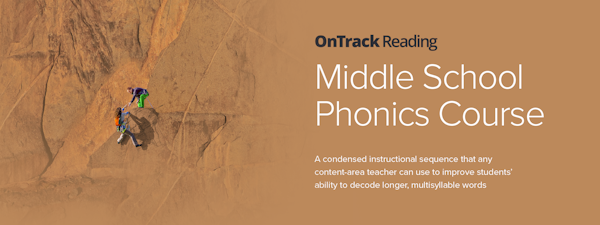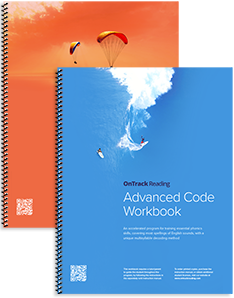The OnTrack Reading Middle School Phonics Course is a mini-curriculum that any content-area teacher in middle school, or even high school, can use to improve your weaker readers’ ability to read multisyllable words. It's designed to be ten 15-minute blocks to be spread over ten class sessions and is based on the Multisyllable Method of the OnTrack Reading Phonics Program.
Following the completion of the ten lessons, the information taught can be productively reinforced by discussing the code structure in some of the more complicated content-area vocabulary words.
Middle School Phonics Course - Digital Download
Program Format and License
The Middle School Phonics Program is available as an inexpensive PDF.
When you purchase it, you get a lifetime license for one teacher. So, if a school has multiple teachers wanting to use the program, they'd buy a license for each. But if you're an individual teacher buying it, you can use it in all your classes for years to come.
The Potential of This Mini-Curriculum
If a lot of students in your typical class are having trouble with the more complex vocabulary words in your regular curriculum, it's likely that they missed out on phonics instruction in elementary school. In this mini-curriculum, you will be teaching them an efficient way to attack multisyllable words phonetically. In addition, you will be setting them up to improve their phonics knowledge on their own, especially if you take the time during the year to help them break down the phonics code in some of your more difficult content-area vocabulary words.
In short, by dedicating roughly three hours of your class time to this mini-curriculum (and it is a sacrifice, I know), you have the potential, as Christine V. highlights in the nearby quote, to elevate the reading skills of many students. This improvement can benefit them not just during their tenure with you, but for the rest of their schooling and beyond.
Furthermore, if you take the time to reinforce the lessons during the rest of the semester, their phonics knowledge will continue to improve. All you need to do is display a few vocabulary words each week somewhere in your room and mark up the the phonics coding in each word.
The marking system I use is simple to use and understand. It's described in the article The OnTrack Reading Coding System. Once you've taught the mini-curriculum, it will be easy for you to pick up.
Prep Time is Always a Consideration
The program isn't scripted, but it is designed so that you can see clearly how to present each day's fifteen minute lesson. The daily preparations are also clearly described for each lesson. You can download an example below to see how the lessons plans are structured.
As with any new curriculum, you'll have background information to learn, especially if phonics is a subject you haven't thought about in a long time. But this is a program that, once you've learned it, can be used year after year if you've been frustrated by having too many students who struggle reading your content-area vocabulary words.
Getting Up to Speed
You will learn all you need to know about breaking multisyllable words down into chunks while you're teaching the ten lessons in the mini-curriculum. To gain a fuller understanding of our unique method for decoding multisyllable words, you could read the Multisyllable Method Overview article, which describes the foundation upon which the OnTrack Reading Middle School Phonics Course is based. However, if you do purchase the PDF of the mini-curriculum, you will find a similar, but more comprehensive, discussion there.
Other Resources to Help You
The PDF has several appendices you can use to get a good grasp on the phonics code. One of them is the Notation for the 43 Sounds that you can also check out here. It has the notation we use when discussing the phonics code and you should use it with your students.
Also, we offer a set of Free Phonogram Flash Cards that will give you an idea how we have organized the phonics code in all of the OnTrack Reading materials. Again, appendices in the PDF will also cover that code, but if you look at the flash cards you'll get a good idea of the scope of the phonics information involved. The information on those cards is what you'll be sharing with your students over the remainder of the year as you go over vocabulary words following the ten-lesson curriculum.
Only Have a Few Poor Readers?
If your students didn't get good phonics instruction in elementary school, you probably have a lot of "guessers" in your class. They look at an unfamiliar long word, pick up a few clues from its length, how it begins, and context, and take a guess at it. If you see that a lot, your students need this curriculum.
However, if you only have a few students in your class having trouble reading longer words, It's possible that they have been dealing with undiagnosed vision problems of the sort discussed elsewhere on this site. See Eye Convergence and Reading Ability for an example.
Also, it's quite possible that by middle school or high school a student's vision problems will either have resolved or that his visual system has accommodated somehow to compensate for his particular problem. In that case, the student might finally be receptive to phonics instruction, even if he struggled in the early grades. Again, the mini-curriculum here will pull things together for such a student very quickly, especially if he was taught phonics earlier.
Be aware, however, that a student might still be dealing with issues that can make reading quite difficult, even though he or she might be one of your best students. Though such students might easily comprehend the information presented in the mini-curriculum, they might not practice it enough to internalize it because of a general avoidance of print.






